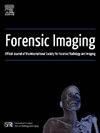Stature estimation based on vertical measurements of the skull using three-dimensional images from postmortem computed tomography in a Japanese population
IF 1
Q4 RADIOLOGY, NUCLEAR MEDICINE & MEDICAL IMAGING
引用次数: 0
Abstract
We aimed to evaluate the correlation between stature and vertical skull measurements based on three-dimensional (3D) computed tomography (CT) images, develop a stature estimation formula, and validate it in a Japanese population. The “training” and “validation” datasets consisted of 275 and 49 identified individuals who underwent postmortem CT. Two skull measurements, the linear distances from the basion to the bregma (Basion–Bregma) and the posterior nasal spine to the bregma (PNS–Bregma), were obtained from 3D CT images that solely extracted cranial data. Pearson product-moment correlation coefficients assessed stature-skull correlations. Multiple regression analysis was performed to assess whether stature was dependent on sex. A stature estimation formula was developed based on the regression analysis. Validation tests were performed for each formula. Significant correlations were observed between stature and skull measurements. The correlation coefficients were 0.790 for stature and Basion–Bregma, and 0.782 for stature and PNS–Bregma. Sex status was statistically significant as an independent variable in regression analysis and influences the estimation of stature. For the stature estimation formula, the coefficient of determination adjusted for the degree of freedom (R*2) was 0.730, and the standard error of estimation (SEE) was 5.55 cm when using three variables: sex status, Basion–Bregma, and PNS–Bregma. The validation test exhibited high reliability; mean error (MA) = 0.10 cm and mean absolute error (MAE) = 4.64 cm. Vertical skull measurements from 3D CT images may be helpful for stature estimation in Japanese individuals, particularly in cases where better predictors are unavailable.

基于日本人群死后计算机断层扫描三维图像的头骨垂直测量的身高估计
我们的目的是评估基于三维计算机断层扫描(CT)图像的身材与垂直头骨测量值之间的相关性,开发一种身材估算公式,并在日本人群中进行验证。训练 "和 "验证 "数据集分别由 275 人和 49 人组成,他们都接受了尸检 CT。两个头骨测量值,即从基底到前囟的线性距离(Basion-Bregma)和从后鼻骨脊到前囟的线性距离(PNS-Bregma),都是从仅提取头骨数据的三维 CT 图像中获得的。皮尔逊积矩相关系数评估了身材与头骨的相关性。进行多元回归分析以评估身材是否取决于性别。在回归分析的基础上制定了一个身材估算公式。每个公式都进行了验证测试。结果表明,身材与头骨测量值之间存在显著的相关性。身材与 Basion-Bregma 的相关系数为 0.790,身材与 PNS-Bregma 的相关系数为 0.782。在回归分析中,性别状况作为一个自变量对身材的估计有显著的统计学影响。使用性别状况、Basion-Bregma 和 PNS-Bregma 这三个变量估算身材时,经自由度调整的决定系数(R*2)为 0.730,估算标准误差(SEE)为 5.55 厘米。验证测试显示出较高的可靠性;平均误差 (MA) = 0.10 厘米,平均绝对误差 (MAE) = 4.64 厘米。通过三维 CT 图像进行头骨垂直测量可能有助于估计日本人的身材,尤其是在没有更好的预测指标的情况下。
本文章由计算机程序翻译,如有差异,请以英文原文为准。
求助全文
约1分钟内获得全文
求助全文
来源期刊

Forensic Imaging
RADIOLOGY, NUCLEAR MEDICINE & MEDICAL IMAGING-
CiteScore
2.20
自引率
27.30%
发文量
39
 求助内容:
求助内容: 应助结果提醒方式:
应助结果提醒方式:


